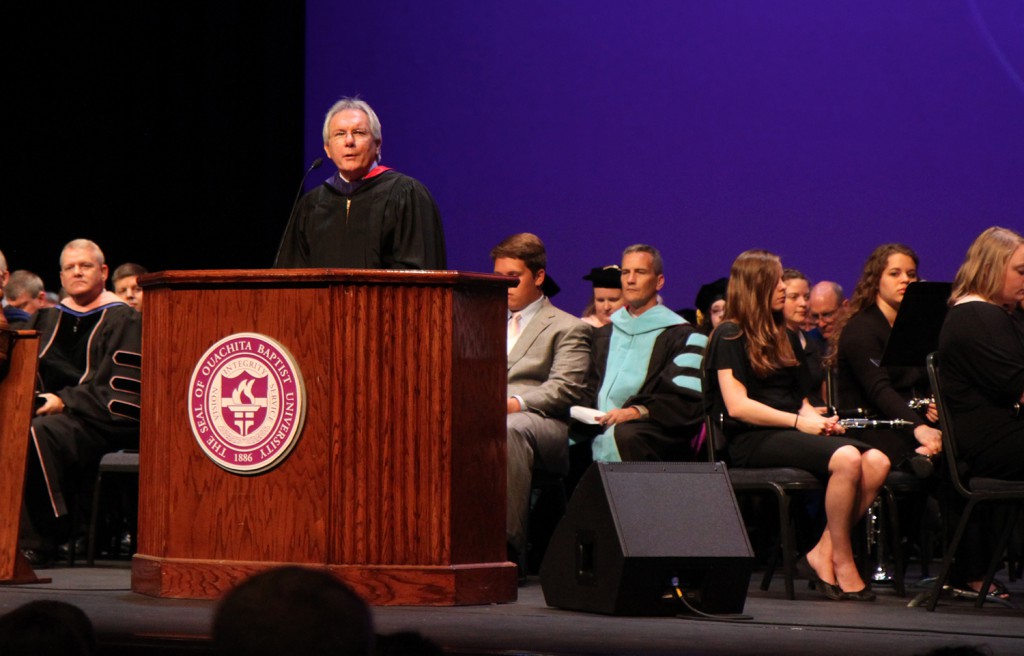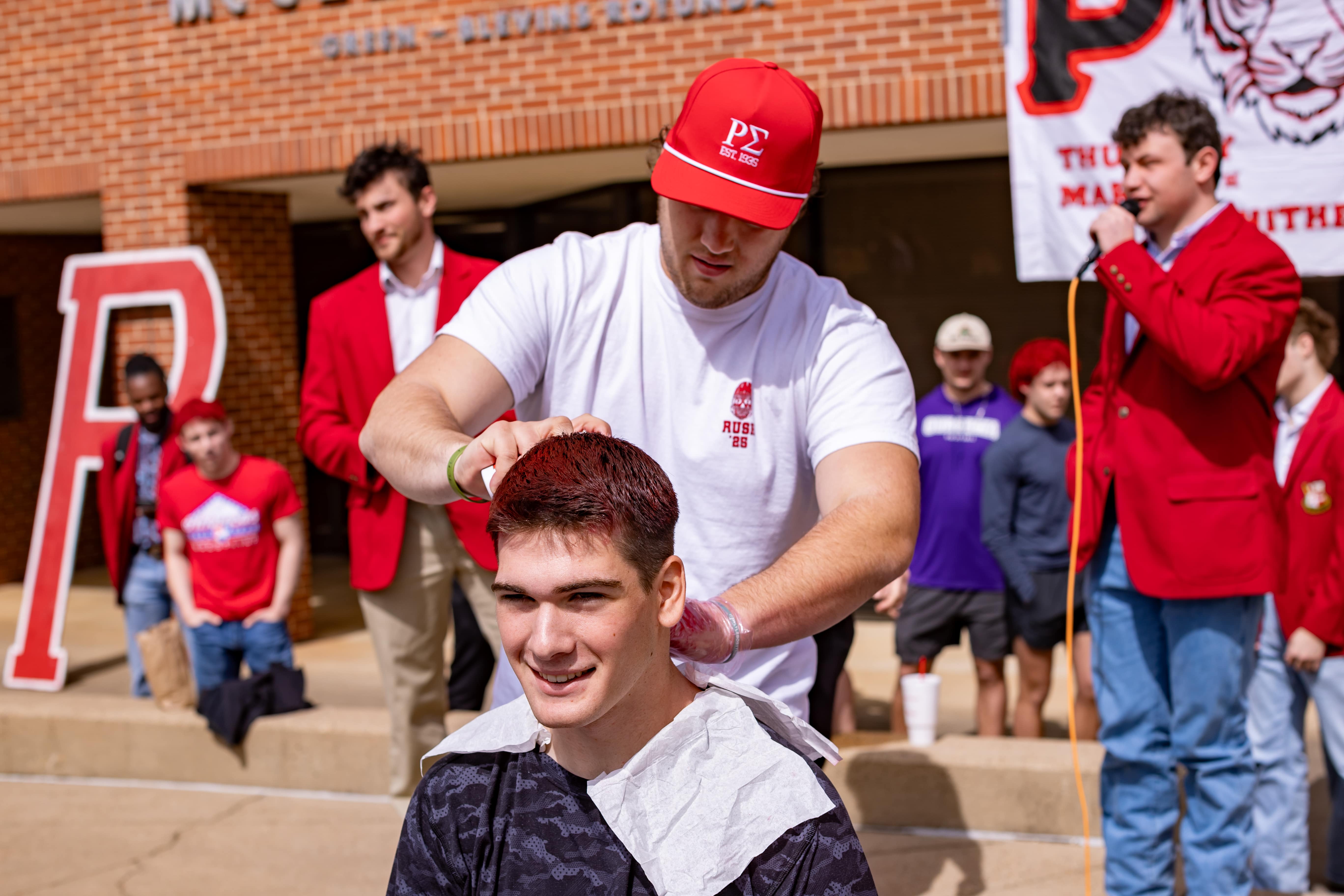ARKADELPHIA, Ark.—Exciting opportunities are unfolding in the field of natural science research at Ouachita Baptist University. This past summer, more than 30 Ouachita students and faculty conducted a variety of research efforts on- and off-campus.
“Our goal is to provide research experiences for our students that set them apart from their peers,” said Dr. Tim Knight, professor of biology and dean of OBU’s J.D. Patterson School of Natural Sciences. Research takes place year-round, but many students choose the summer option.
Ryan James, a senior biology major from Benton, Ark., worked this summer under Dr. Lori Hensley, associate professor of biology and holder of the J.D. Patterson Chair of Biology. “Dr. Hensley has been using a drug known as anjulemic acid, or AJA, for several years now,” James explained. He said Dr. Hensley’s research has shown the drug “has the ability to kill Ewing’s Sarcoma tumor cells without any harmful side effects.
“Ewing’s is an aggressive pediatric bone tumor with a very low survival rate – about 20 percent,” he added. “The only treatment options available currently are surgery, chemotherapy, radiation or a combination of the three. AJA provides a very safe and specific treatment option for this type of cancer and has the potential to cure a lot of individuals.”
Dr. Hensley’s research “fascinated me to know that somebody was curing cancer at Ouachita, in the science building, where I take classes every day,” James said. “I knew I had to have a part in this and wanted to learn more.
“I went into it thinking we were going to make some monumental breakthrough in the research, but I realized that’s not how it works,” James added. “Sometimes you have to discover the little things and rule out certain possibilities in order to pave the way for the next person down the road.”
Skylar Hearron, a senior biology major from Monticello, Ark., also conducted research on campus this summer. She worked under Dr. Ruth Plymale, assistant professor of biology. They researched “the ability of cranberry juice and mouthwash to both inhibit biofilm formation and remove existing biofilms,” Hearron said. They tested several different juices and Listerine products.
Biofilms are “communities of bacteria that grow within a slime matrix and attach to a surface,” noted Dr. Plymale. “Plaque on your teeth is an example of a biofilm – it’s why your teeth can feel fuzzy if you haven’t brushed in a while. The biofilms are formed when a bacterium attaches to moist surface. It then begins to divide and produce the slime matrix. Once the biofilm is formed, it is more resistant to chemicals, including antibiotics, than free-floating bacteria.”
“The study of biofilms has increased drastically in recent years due to awareness of the impact of biofilms on natural and industrial systems, as well as human health,” said Hearron.
“We found out that the cranberry juice can inhibit bacteria from attaching to surfaces and can decrease biofilm formation,” Plymale said. These results, based on previous research, were expected. “We found that most of the Listerine types that we tried were able to both inhibit bacterial attachment and remove existing biofilms. The whitening Listerine consistently decreased biofilms the most – we think this is because the whitening Listerine contains hydrogen peroxide, which damages the bacterialcells.”
“Working with Dr. Plymale was an amazing experience,” Hearron said. “She is so passionate about the work she does and that is what made my research experience so great. She encouraged me to think on my own, which helped me to develop many critical thinking skills.”
“The students in OBU sciences are fantastic,” Plymale said. “Most of them know where they want their careers to go and, for the most part, are committed to doing what needs to be done to get them there. Science isn’t the right path for everyone, but the students that remain in science are hard-working, curious, responsible and really want to succeed.
“All our science research has a long-range application, a purpose that it can be used for or a question that it can help solve in the future,” Plymale added. “But I think that the most important component of the research we do is that it trains our students to be scientists. Students who go through research tackle a problem, figure it out and communicate their work to others.”
Other students who researched on campus this summer included Amelia Lindsey, a junior biology major from Camden, Ark., and Cara Cox, a junior biology major from Bentonville, Ark.
Lindsey conducted botany research under Dr. Jim Taylor, professor of biology, “to see how plants will grow in space, under microgravity and a different atmosphere, so that long-term space travel will be possible and there will be a sustainable food source.”
Cox worked under Dr. Sara Hubbard, assistant professor of chemistry, to research the “effects of BPA, a chemical that leaches out of food packaging and plastic bottles.” They worked to determine how much BPA, Bis-phenol A, is “harmful to marine life, pregnant women and small children,” Cox said.
Ouachita students also completed research at other institutions. Valerie Nickel, a senior chemistry and biology double major from Richardson, Texas, worked in the biochemistry program at Texas A&M. “I worked with a protein that was designed to deliver macromolecules to cells,” Nickel said. “The protein is a combination of different peptides, which are parts of different proteins stuck together for a specific purpose. Part of the protein is from the influenza virus, part is from HIV and another part is just a fluorescent protein, like for a marker.
“There were only 14 students in the program I was in,” Nickel said. “There were other programs like aerospace and engineering, though. They put everyone who was doing research in our building, which was cool because it created a community for us to live in.”
On a typical morning, Nickel would review experiments and talk with her mentor about what they were doing that day so he could walk her through procedures before she did them on her own. “Most of what my day consisted of was doing experiments or data analysis of results,” she said.
“I learned so much that I would have never learned from just taking classes,” Nickel said. “I got to work with people who were doing the science that you learn about in textbooks.”
Hollyn McCarty, a senior chemistry and biology double major from Fouke, Ark., also took part in off-campus research at theArkansas Children’s Hospital Institute in Little Rock.
“My research focused primarily on the QTc interval in non-syndromic supravalvar aortic stenosis (NSVAS) patients,” said McCarty. The QTc interval “has to do with the electrical signals that travel through the heart. It causes the ventricles to contract and relax. The timing of atrial and ventricular depolarization and repolarization are staggered, creating the pumping movement of the heart. It’s a really cool concept that everything has to be timed so well for the heart to pump and that it does so day in and day out until we die.
“NSVAS patients often exhibit a cardiac phenotype, the way their heart looks physically, similar to that found in Williams syndrome, which is a congenital disease that often results in mental retardation and cardiac anomalies,” McCarty said. “We were examining the length of the QTc interval in NSVAS patients and its correlation, or lack thereof, to the amount of supravalvar aortic stenosis present in the patient population in order to better understand the differences in the risk level for sudden cardiac death in the Williams syndrome and NSVAS patients.”
McCarty was “working primarily with clinical data that had been collected by physicians over many, many years. I entered the data that we were interested in into a large database. There were some daysthat I was given the opportunity to shadow in the various medical specialties and see different medical procedures.
“While I’ve always been aware that I am getting a wonderful education at OBU, the knowledge instilled in me by the chemistry and biology departments truly became apparent during the summer,” McCarty noted. “You never realize how much you’ve learned until you’re in a situation where you are forced to apply it in everything you do.”
For more information about Ouachita’s Patterson School of Natural Sciences, contact Dr. Tim Knight at knightt@obu.edu or (870) 245-5528.








